#roxy rothafel
Text

The Roxy Hour, a weekly variety show on the NBC radio network, was immensely popular for ten years. Here, his performers line up at the Roxy Theater to sing a few hot numbers to take a little bit of the chill out of the frosty air, December 1929.
Photo: John Reidy for the NY Daily News
#New York#NYC#vintage New York#1920s#John Reidy#Roxy#Roxy Rothafel#radio#vintage radio#early radio#Roxy Hour#Roxy Gang#Roxy Theater
36 notes
·
View notes
Text

The cast of the popular radio variety show The Roxy Hour broadcasts from the stage at the Capitol Theatre in New York City, 1929. Directed by American showman Samuel "Roxy" Rothafel, the troupe of players known as "Roxy's Gang" enjoyed an audience that averaged five million listeners on NBC's Blue Network.
33 notes
·
View notes
Text





Center Theatre (New York City)
The Center Theatre was a theater located at 1230 Sixth Avenue, the southeast corner of West 49th Street in Rockefeller Center in New York City. Seating 3,500, it was originally designed as a movie palace in 1932 and later achieved fame as a showcase for live musical ice-skating spectacles. It was demolished in 1954, the only building in the original Rockefeller Center complex to have been torn down.[
History
Radio City - RKO Roxy Theatre ad from, The Film Daily, 1932
The Center Theatre was originally called the RKO Roxy Theatre and built as part of the construction of Rockefeller Center. The RKO Roxy started construction in November 1931,[2] and it opened December 29, 1932 with the RKO film The Animal Kingdom and a live stage show. It was intended as a smaller sister to the 6,000 seat Radio City Music Hall one block away, which at first did not show films. The smaller theater was named after producer Samuel L. Rothafel, aka "Roxy", who was engaged by Rockefeller Center to supervise the design and operation of the two theaters.[3][2] After the initial failure of the Music Hall in its first weeks, Rothafel suffered a heart attack and never returned to his new theaters. A successful lawsuit in 1933 by the owners of the original Roxy Theatre on Seventh Avenue, claiming ownership of the "Roxy" name, caused the new theater to be renamed the RKO Center.
The Center Theatre featured an elegant Art Deco design which was muted by comparison to the lavish Radio City Music Hall. The architect was Edward Durrell Stone and decor was by Eugene Schoen. The spare but striking design featured curved walls paneled in mahogany. It had a three-tiered metal chandelier weighing six tons, and a ceiling studded with circles decorated in half-relief with mythological figures. Three shallow mezzanines provided an unobstructed view of the stage. The large stage contained turn-screw lifts as did the orchestra pit. There was also a 34-rank Wurlitzer theatre organ with a single stained wood console at stage right similar to the Radio City Wurlitzer twin consoles which were finished in ebony. Betty Gould and Raymond Bohr were some of the organ's featured artists.[4]: 46
Originally operated by the RKO movie theater chain, the Center was soon overshadowed in the movie business by the hugely popular Music Hall. In 1934 it converted to presenting Broadway plays and musicals. Now called the Center Theatre, it offered The Great Waltz and a few other shows but the theater was too large to find lasting success in this venture either.
The last feature film to play at the theatre was Walt Disney's Pinocchio in 1940.
Looking for a way to make the Center Theatre profitable, Rockefeller Center, inspired by the theatrical success of figure-skating champion Sonja Henie, converted it into a theater expressly designed for the presentation of musical ice shows.[4]: 51 This venture was headed by G.S. Eyssell, executive manager of Rockefeller Center, and Arthur M. Wirtz, of Chicago. RKO Roxy Theatre, 49th Street, New York, N.Y., 1932
An ice stage 100 feet (30 m) wide with a skating surface of 7,000 square feet (650 m2) was built in the theater. Beneath it 28,000 feet (8,500 m) of pipe were laid, capable of continuously circulating a freezing solution at the rate of 500 US gallons per minute (1,900 L/min). For the surface, specially designed ice-making machinery was installed. The result was a permanent frozen stage surface that was ideal for skating.
As an ice theater, the Center Theatre reopened on October 10, 1940 with the presentation of Sonja Henie's production, It Happens on Ice, first of the musical ice spectacles. This proved to be a popular new form of entertainment. The show was a huge success, attracting greater than 1.5 million people during its run. For the next several years the Center offered more ice spectacles produced by Henie and Wirtz, including: Stars on Ice, Hats Off to Ice, Icetime, and Howdy Mr. Ice. In addition, during this time the Center was the home for the spring season of the San Carlo Opera Company from 1944 to 1949.
The Center Theatre had never been able to become a consistently profitable venture for Rockefeller Center.[5] In 1951, the theatre was leased by NBC and became a venue for live television broadcasts. Many early programs, including The Voice of Firestone and Your Show of Shows, were broadcast from the Center Theatre. Two years later, the United States Rubber Company indicated that it wanted to expand the U.S. Rubber Company Building above the Center Theatre, meaning that the theater had to be closed and demolished to make way for the extra office space.[6]
After 21 years of operation, the Center Theatre was demolished in 1954 and replaced with a 19-story addition to the U.S. Rubber Company Building. The final production at the theatre was the New York-portion of the 1954 Academy Awards, when Audrey Hepburn won Best Actress for Roman Holiday.[5] During the demolition process, the U.S. Rubber Building above it was put on temporary stilts, with the offices above the former theater still being occupied during the demolition process.[7] Doors, lamps, and other furnishings were sold off to the Cherry Lane Theatre in the West Village.[8] Bob Jones University purchased the stage lifts and turntables from the Center Theatre and reassembled them in its Rodeheaver Auditorium, where the mechanisms are still in use today.[9]
Known for most of its short life as the Center Theatre, this Art Deco-style movie palace on the southeast corner of Sixth Avenue and 49th Street was located in the south block of Rockefeller Center. It opened as the New RKO Roxy Theatre on December 29, 1932 with a stage show and the movie "The Animal Kingdom," starring Leslie Howard and Myrna Loy. Two days earlier, its larger sister theatre, Radio City Music Hall, had opened with a stage show-only policy, under the direction of S.L. "Roxy" Rothafel.
The lobby had three ticket offices. The Grand Foyer was illuminated by day through five large exterior windows of opaque glass etched in relief. During darkness, the lighting was via three glass globes at ceiling height and two glass globes hanging lower. It was decorated in red and gold fabric with Bubinga mahogany walls and vermilion doors leading to the auditorium.
The auditorium had 75-foot-high walls that were paneled with African mahogany and a ceiling decorated with figures from Greek mythology. Centered over the orchestra section was a 400-bulb, 104,000-watt chandelier, 25 feet in diameter and weighing six tons. Claimed as the largest of its kind, the fixture required its own fan cooling system. The proscenium opening was 60 feet wide and extended in height from stage floor to the ceiling. Just as in Radio City Music Hall, the New RKO Roxy Theatre had three shallow mezzanines, with respective seating capacities of 406, 655 and 559. The orchestra accomodated 1,890, giving the theatre a total capacity of 3,510. The Grand Foyer was also similar to that at Radio City Music Hall in that it had a wide staircase and elevators to the top mezzanine, and a Grand Lounge in the basement.
In March 1933, the New RKO Roxy Theatre and Radio City Music Hall shared the New York premiere engagement of "King Kong." Both theatres supported the movie with a stage show, "Jungle Rhythms."
After successful litigation by the owners of the original Roxy Theatre on 7th Avenue and 50th Street, the New RKO Roxy was renamed the RKO Center Theatre in 1933, and it began to feature less costly second-run double bill film programmes. In 1934, "RKO" was dropped from the Center's name when it opened its first legitimate production, "The Great Waltz." When the show closed, the Center Theatre attempted showing films again. In February 1940, it hosted the New York premiere engagement of Walt Disney's "Pinocchio." Movies did not succeed here, and the Center Theatre returned to presenting live shows, including some 'Ice Spectaculars,' until it closed and became an NBC studio in 1950.
By the time NBC's lease expired, in May 1954, a decision had been made to demolish the theatre. In its place an office skyscraper that blended with other buildings in Rockefeller Center was built.




1 note
·
View note
Text
Events 3.11 (before 1950)
222 – Roman emperor Elagabalus is murdered alongside his mother, Julia Soaemias. He is replaced by his 14-year old cousin, Severus Alexander.
843 – Triumph of Orthodoxy: Empress Theodora II restores the veneration of icons in the Orthodox churches in the Byzantine Empire.
1343 – Arnošt of Pardubice becomes the last Bishop of Prague (3 March 1343 O.S.), and, a year later, the first Archbishop of Prague.
1387 – Battle of Castagnaro: Padua, led by John Hawkwood, is victorious over Giovanni Ordelaffi of Verona.
1641 – Guaraní forces living in the Jesuit reductions defeat bandeirantes loyal to the Portuguese Empire at the Battle of Mbororé in present-day Panambí, Argentina.
1649 – The Frondeurs and the French government sign the Peace of Rueil.
1702 – The Daily Courant, England's first national daily newspaper, is published for the first time.
1708 – Queen Anne withholds Royal Assent from the Scottish Militia Bill, the last time a British monarch vetoes legislation.
1784 – The signing of the Treaty of Mangalore brings the Second Anglo-Mysore War to an end.
1795 – The Battle of Kharda is fought between the Maratha Confederacy and the Nizam of Hyderabad, resulting in Maratha victory.
1845 – Flagstaff War: Unhappy with translational differences regarding the Treaty of Waitangi, chiefs Hōne Heke, Kawiti and Māori tribe members chop down the British flagpole for a fourth time and drive settlers out of Kororāreka, New Zealand.
1848 – Louis-Hippolyte Lafontaine and Robert Baldwin become the first Prime Ministers of the Province of Canada to be democratically elected under a system of responsible government.
1851 – The first performance of Rigoletto by Giuseppe Verdi takes place in Venice.
1861 – American Civil War: The Constitution of the Confederate States of America is adopted.
1864 – The Great Sheffield Flood kills 238 people in Sheffield, England.
1872 – Construction of the Seven Sisters Colliery, South Wales, begins; it is located on one of the richest coal sources in Britain.
1879 – Shō Tai formally abdicates his position of King of Ryūkyū, under orders from Tokyo, ending the Ryukyu Kingdom.
1888 – The Great Blizzard of 1888 begins along the eastern seaboard of the United States, shutting down commerce and killing more than 400 people.
1917 – World War I: Mesopotamian campaign: Baghdad falls to Anglo-Indian forces commanded by General Frederick Stanley Maude.
1927 – In New York City, Samuel Roxy Rothafel opens the Roxy Theatre.
1941 – World War II: United States President Franklin D. Roosevelt signs the Lend-Lease Act into law, allowing American-built war supplies to be shipped to the Allies on loan.
1945 – World War II: The Imperial Japanese Navy attempts a large-scale kamikaze attack on the U.S. Pacific Fleet anchored at Ulithi atoll in Operation Tan No. 2.
1945 – World War II: The Empire of Vietnam, a short-lived Japanese puppet state, is established.
1946 – Rudolf Höss, the first commandant of Auschwitz concentration camp, is captured by British troops.
0 notes
Text

The above photograph shows violinist/musical director Ignace Frank Nowicki as a teenager in his 1917 yearbook entry from when he attended the New England Conservatory of Music. Nowicki rests with his parents in Woodlawn’s Rhododendron plot.
Ignace Nowicki (who sometimes went by the names I. Frank Nowicki or Frank Nowicki) wasn’t an “important” person in the music industry but he stands out to me because of his deep passion for his craft—he not only lived for music, he died for it.
In 1967 he was 71 years old and living in an apartment on the 2nd floor of a house on Long Island when a fire broke out there. A neighbor later told a newspaper reporter that he saw Mr. Nowicki leaving the house dragging a burning piece of furniture with him. If he’d remained outside he would have most likely survived the fire, but apparently Nowicki went back into the house specifically to retrieve his violin. He was found dead inside his apartment by firefighters, his violin by his side.
The son of Polish immigrants who lived in the Bronx, Nowicki began his musical training at age 8. As World War I was raging in 1918, he performed at a wartime bond drive presented by Boston department store Jordan Marsh:
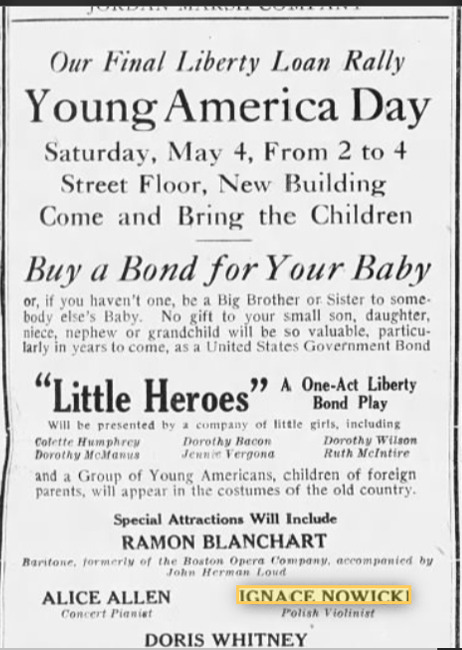
(ad from the Boston Globe, May 3, 1918)
Early in his career Nowicki played first violin in the Victor Herbert Symphony Orchestra. By the mid 1920s, he was part of S.L. “Roxy” Rothafel’s Capital Theatre Orchestra; they were heard on the radio every Sunday night. According to Ross Melnick’s biography of Roxy Rothafel, the show was wildly popular and thousands of fan letters were sent to Rothafel. (https://en.wikipedia.org/wiki/Samuel_Roxy_Rothafel)

Nowicki must have had a good reputation with Rothafel’s organization; after playing with the Capital Theatre Gang, Nowicki was appointed as one of the Roxy Theatre conductors in 1931 and then associate conductor at Rothafel’s Radio City Music Hall in the late 1930s/early 1940s.
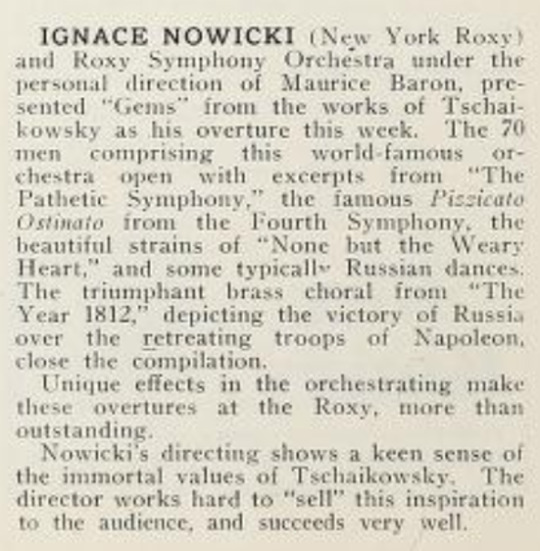
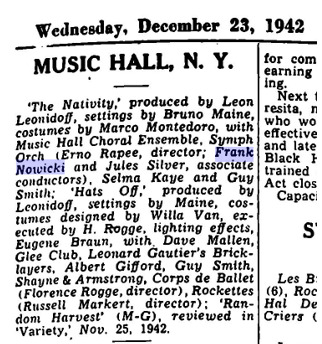
After that, Nowicki turned to Broadway, becoming assistant conductor or musical director for the classic 1940s/1950s musicals “Bells Are Ringing”, “South Pacific” and “On The Town.” Papers found by Nassau County Police in Nowicki’s home after his death showed that he had also been involved with “Show Boat” and “Gypsy” and played with the tour companies of various shows.
Nowicki never retired—neighbors told reporters that he’d been about to leave for Minneapolis to begin a concert tour when he died.
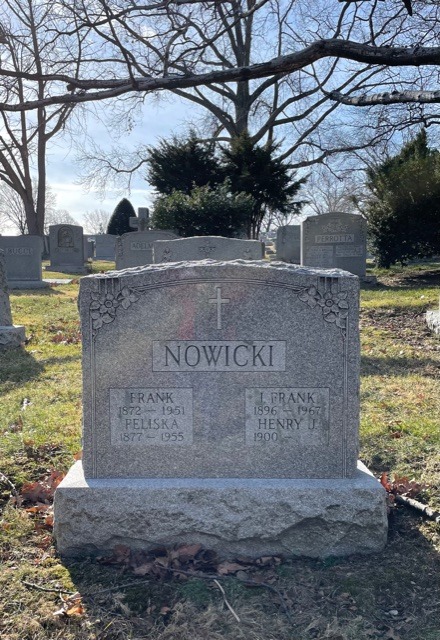
5 notes
·
View notes
Text
Gas Tanks & Towers
Gas Tanks & Towers
Lewis Mumford (1895–1990) is best known as a critic of art, architecture and urban design, but he was unique — especially for his time — in how he approached these subjects, going far beyond aesthetics to consider how things aligned, or mis-aligned, with necessary human qualities ranging from comfort and scale to the quality of our air, water and even diet.
Oct. 22, 1932 cover by Peter…

View On WordPress
#American Communists#E.B. White#Frances Fuller#Helen Hokinson#Henry Anton#Henry Wright#Humphrey Bogart#James Thurber#John Floherty Jr.#Lewis Mumford#Maddy Vegtel#New York architecture 1930s#Rea Irvin#Robert Benchley#Robert D. Kohn#Samuel Lionel "Roxy" Rothafel#William Crawford Galbraith
0 notes
Photo

Gloria Swanson photographed by Eliot Elisofon in the ruins of the Roxy Theatre on October 14, 1960.
Dubbed ‘THE CATHEDRAL OF THE MOTION PICTURE’ by creator and namesake Samuel ‘Roxy’ Rothafel, the Roxy was located at 153 West 50th Street between 6th and 7th Avenues. The Roxy opened with the silent film The Love of Sunya, produced by and starring Gloria Swanson.
24 notes
·
View notes
Text
IT HAPPENED LAST NIGHT: LUCY & THE BOMPS!
by Earl Wilson, August 19, 1950


Lucille Ball wanted to keep Desi home and off the road so she petitioned for him to play her husband on radio’s “My Favorite Husband”. The network balked and Richard Denning got the role instead. When it came time to transfer the show to television, Lucy made the same demand. Now a radio star in her own right, she was able to convince the network - nervous about America believing an ‘All-American girl’ like Lucy would be married to a Latin bandleader - to give them a chance to prove it! The Arnazs’ built a comedy and musical act and took it on the road. When the show got to the Roxy in New York City, syndicated columnist Earl Wilson tagged along and wrote the following feature, which appeared on August 19, 1950. Coincidentally, the Roxy was also the theatre where Desi Arnaz was performing when he wed Lucille Ball in 1940.
[NOTE: Although the text of Wilson’s article is repeated below verbatim, the photos and footnotes were added for editorial consideration.]

Lucille Ball has been one of our most appreciated movie actresses for quite a while, but it was seeing her do a bump on the stage that made me really come to realize how talented she is.
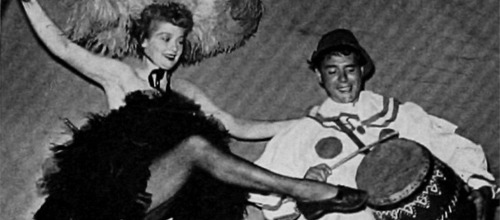
It was after she’d done her clever act with husband Desi Arnaz at the Roxy that I talked to the flamin’ redhead about it.

“Wasn't that a bump?” I asked her, as we got into a cab and pulled away from the stagedoor. I wanted to be sure, because some snooty actresses wouldn’t want it thought that they ever did a bump.“That was a married woman’s refined version of a bump.”
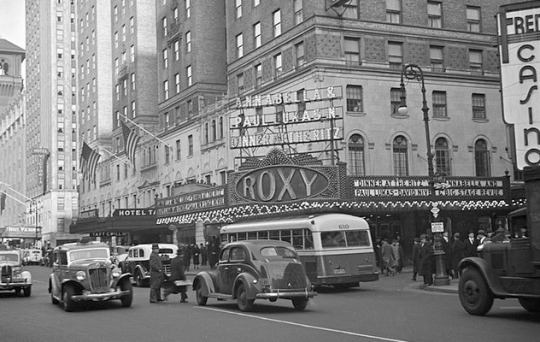
Lucille was sitting back in the cab, exhausted from several shows that day, and clamoring to be taken somewhere to see a show. She said she had been entertaining all day and now she wanted to be entertained for a change.

“Did you say refined?” Desi looked across the cab at her. I was between them. “Any harder you do it and you will knock my hot off,” he said in his charming accent. (1)

At Desi’s urging, she told me a story showing that doing the bump is for her not new. It seems that once she made a picture for Eric Palmer called Dance, Girl, Dance. (2)
“He was telling me, ‘Those bomps. Don’t do those bomps bad or the sansors will keep the picture.’
“So I was doing a very tame dance, not bumping at all. I had on a 27-pound dress, silver lame, with bugle beads, and it rolled from side to side when I shook.
“Durin’ a scene, Palmer jumped up and said, ‘Oh, oh, that was a bomp. I told you no bomps.’
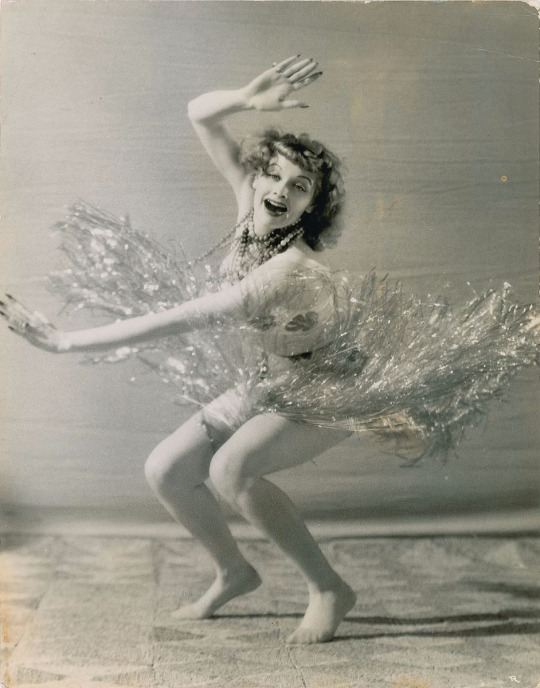
“I went up to him and I said, ‘Mr. Palmer, that was not a bomp. THIS is a bomp.’ “And I bumped and I wrapped those 27 pounds of beads right around his neck!”
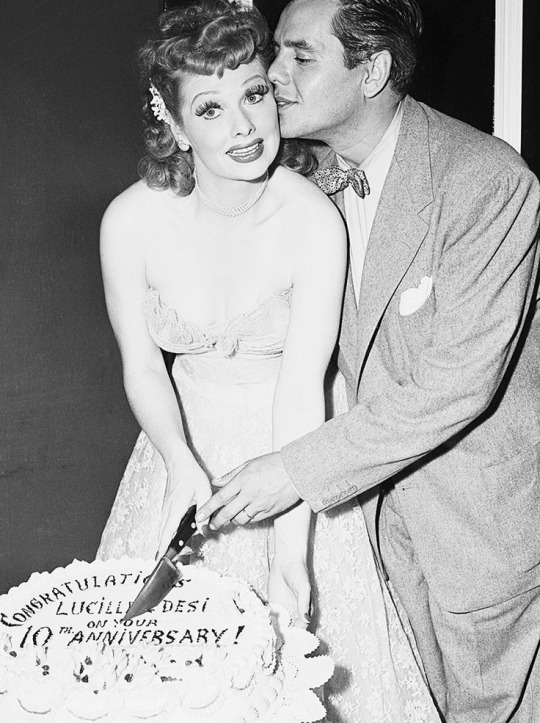
It’s a pleasure to talk to two such honest, earthy people after listening to some others who are always posing. A lot of people are astonished that they are celebrating their 10th wedding anniversary because, as Desi points out, “Everyone said it wouldn’t last a month.” “And WE didn’t think it would last a week,” Lucille said. (3)
Being romantically inclined, I asked for the details which most everybody must have forgotten by now but the participants themselves.
“Where did you get married?” I asked Desi.

“The Byram River Beagle Club, at Greenwich, Conn.,” Lucille said. (4)
“Thank you, I can never say that,” said her Cuban husband.
“Yes, you can. Try it,” Lucille said.

“The By-ram River Bee-gul Club,” Desi said dutifully and slowly.
“Faster!” commanded Lucille. (5)
“The Byver Regal Civer Club,” responded Desi.

“Oh, my,” said Lucille, “We were married by Judge John J. O’Brien. He’s the one who married Tommy Manville so many times.” (6)

Although Desi missed a show at the Roxy, where he was then appearing, to get married, he remembers, just as vividly, how on his wedding night he woke up the bride about 5 A.M. and demanded that she get him a glass of water. The funny thing is that she did.
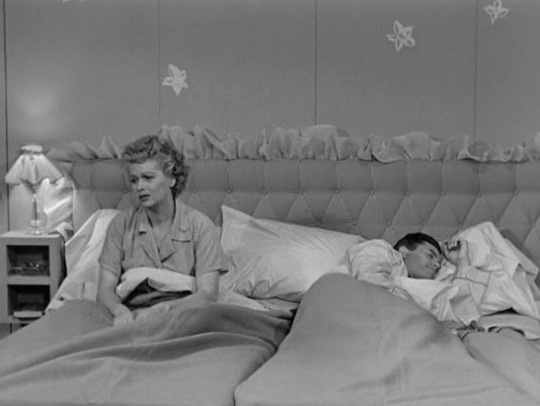
“About 9 o’clock she woke me up,” Desi recalls, “and she said ‘Listen, you—, the next time you want a glass of water you get it yourself!’” (7)
Desi explains that he’s never made such a request since.

Desi and Lucille have formed their own company which they call Desilu Productions, this being a combination, of course of their two first names. “First time I ever got top billing,” Desi says.

They plan to do concerts, radio, television and movies together. Lucille comes from Butte, Mont., and, as everybody knows, has red hair. (8)
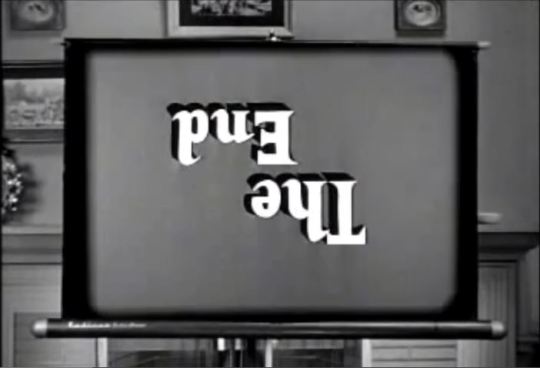
Lucille made up a description of herself around which a movie will be made. The title which describes her so accurately is "Blazing Beulah From Butte," and we figure it ought to get the money. (9)
Never underestimate that Desi.
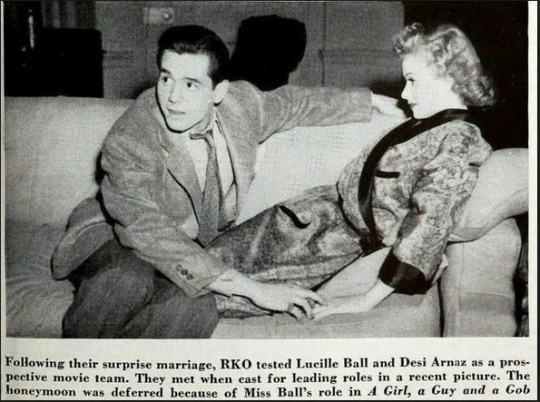
When they were getting married it appeared that she might not be able to because of a commitment to Harold Lloyd.
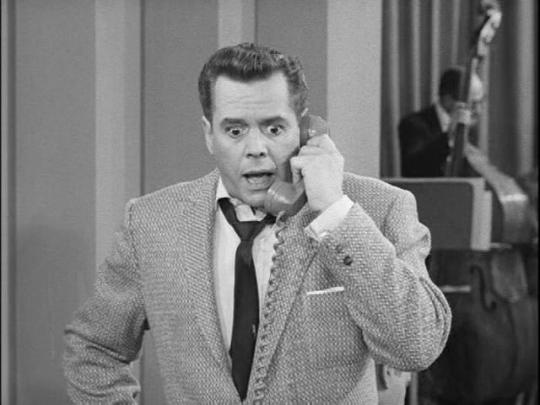
Desi called Lloyd from New York and defiantly announced to him that Lucille couldn’t be available that week, as he was marrying her. “Y-yes, D-desi, c-can she be back next k-weeek?” stammered Lloyd, who never does. (10)
Desi is pretty masterful; when he speaks, to Lucille he is her master’s voice.
FOOTNOTES
(1) The ‘bomps’ discussed are undoubtedly from the “Cuban Pete / Sally Sweet” number, where Lucy gyrates her hips while singing “Chick-Chicky-Boom Chick-Chicky-Boom.” The routine was repeated (with ‘bomps’ included) on “I Love Lucy” in “The Diet” (ILL S1;E3) in October 1951.
(2) The article consistently mis-spells Erich Pommer as ‘Eric Palmer.’ Pommer was the producer of Lucille Ball’s 1940 film Dance, Girl, Dance at RKO.
(3) Lucy and Desi’s marriage lasted twenty years, from 1940 to 1960, although Lucille divorced Desi in the mid-1940s, Lucy never signed the paperwork. After their second divorce was final, Lucy revealed that Desi was unfaithful and a drinker, and that they were no longer compatible. Lucy charged “mental cruelty” and told the court of Desi’s temper tantrums. Some years later, she described the reason for the split as “the same old booze and broads.” Both Ball and Arnaz remarried, although they stayed friends and later admitted that they had always loved one another.
(4) Lucy and Desi married in Connecticut due to its shorter waiting period on licenses and blood tests. The Byram River Beagle Club in Greenwich was originally a Hunt and Kennel Club that became a speakeasy during Prohibition and after that a supper club. It was a favorite hangout of baseball great Babe Ruth. A single-family home now stands on the property. In April 1952, “I Love Lucy” aired an episode called “The Marriage License” (ILL S1;E26) that was largely set in Greenwich and mentioned The Byram River Beagle Club, although no scenes were set there because Lucy purposely left Ricky’s wallet at home and they ran out of gas!
(5) In “The Marriage License” Ricky also had trouble pronouncing the name. On “I Love Lucy” making fun of Ricky’s English was a usual source of comedy - mostly by Lucy - just as it appears to be here - in 1950.
(6) Thomas Franklyn Manville, Jr., known as Tommy Manville (1894-1967), was a Manhattan socialite and heir to the Johns-Manville asbestos fortune. He was a celebrity in the mid-20th Century due to both his inherited wealth and his record-breaking 13 marriages to 11 women, which won him an entry in the Guinness Book of World Records. At the time of this interview, however, Manville was only on his 6th wife! The termination of his marriages usually resulted in gossip, widespread publicity, and huge cash settlements. At the time of his death it was estimated that Manville spent more than $1.25 million on divorce settlements.
(7) This exchange (with slight variation) was later worked into “I Love Lucy”!
(8) At the start of her career - and apparently well into 1950 - Lucille Ball purported to have been born in Butte, Montana, despite her actual birthplace being Jamestown, in upstate New York. Ball (who then went by the name Diane Belmont) thought it sounded more interesting and exotic.
(9) Despite the alliterative title, "Blazing Beulah from Butte” was never made, perhaps because shortly afterwards Ball admitted her true birthplace. “Blazing Beulah from Jamestown” doesn’t have quite the same ring. It’s also likely that this was a clever bon mot on Desi’s part to create a more colorful interview.
(10) Comic actor and director Harold Lloyd had put Lucille under contract for his film A Girl, A Guy, and A Gob, to be filmed in 1940. There was some speculation that marrying Arnaz would interfere with the shooting schedule.
TRIVIA

While Lucy and Desi were at the Roxy, the theatre was also showing Night and the City, which had premiered there on June 5, 1950. At this time it was common for a larger entertainment venues like the Roxy to present both a stage show and a first run film. Night and the City starred Richard Widmark, who Lucy and Desi later convinced to guest-star on “I Love Lucy” in “The Tour” (ILL S4;E30) in May 1955.
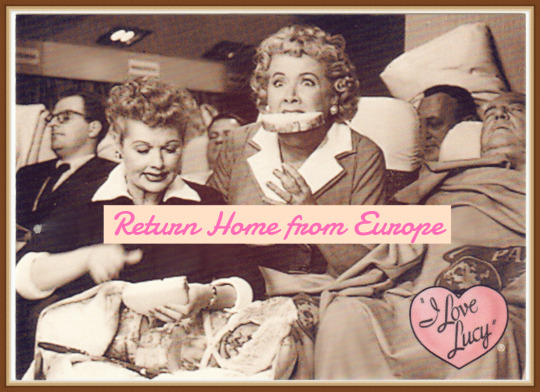
In “Return Home From Europe” (ILL S5;E26), Ricky gets a long-distance telephone call from the manager of the Roxy, Mr. Rothafel, offering him a job, if he can get back to New York immediately. In reality, Rothafel was the name of the founder of the Roxy, Mr. Samuel ‘Roxy’ Rothafel. Rothafel died in early 1936, however, so this was probably Desi’s way of honoring him.

Earl Wilson was mentioned on “I Love Lucy” in “The Fox Hunt” (ILL S5;E16). While trying to wangle an invitation to Sir Clive’s country manor, Lucy makes up a story about the Mertzes meeting an Earl in the hotel lobby. When Sir Clive rattles off the names of some Earls to jog her memory, she fibs that he was just promoted from Assistant Earl, the Earl of Wilson, who canceled because he’s got the gout! Lucy’s imaginary Earl is actually a reference to Earl Wilson (1907-87), a journalist and television panelist of the time. His nationally syndicated column frequently mentioned Lucy and Desi.
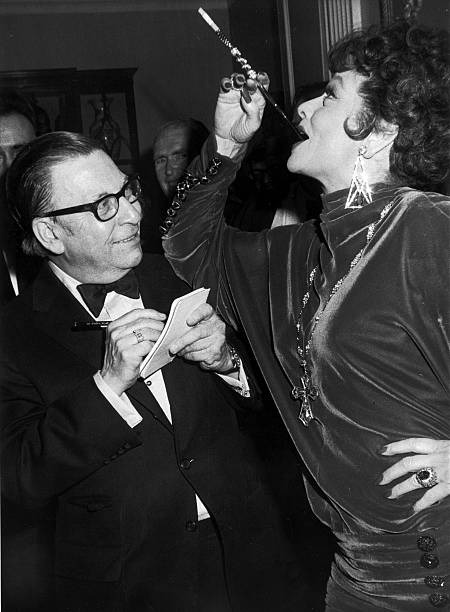
In 1974, Lucy strikes a pose for Wilson during her promotional tour for Mame.
#Earl Wilson#Lucille Ball#Lucy#Desi Arnaz#Desilu#Roxy#Byram River Beagle Club#1950#I Love Lucy#Mame#Night and the City#Tommy Manville#A Girl A Guy and a Gob#RIchard Widmark#Dance Girl Dance#Erich Pommer#Vivian Vance
4 notes
·
View notes
Photo










Rockefeller Center, Manhattan (No. 7)
The east side of Sixth Avenue, officially known as Avenue of the Americas,[222] contains most of the buildings that were built specifically for the proposed radio complex. These buildings, which comprise "Radio City", are 1230 Avenue of the Americas, 30 Rockefeller Plaza, Radio City Music Hall and 1270 Avenue of the Americas. The idea for an integrated media complex somewhere came in 1920, when Owen D. Young, the chairman of RCA parent General Electric, suggested that RCA combine its then-disparate offices into one location.
The western half of the southernmost block of the complex along Sixth Avenue, between 48th and 49th streets, contains the former U.S. Rubber Company Building (now Simon & Schuster Building) at 1230 Avenue of the Americas. The last structure in the original complex to be built, it was topped out in November 1939. The 23-story building contains two 7-story wings on its north and south sides. It was renamed after Uniroyal in 1967, and again after Simon & Schuster in 1976. 1230 Avenue of the Americas was expanded to the east in 1954 after the Center Theatre adjacent to it was demolished. The 19-story annex, designed by Wallace Harrison and Max Abramovitz, had a glass facade on the lowest two stories—reflecting the design of the former American Airlines Building across Sixth Avenue—and a limestone facade above the second story. It is aligned with the axis of 10 Rockefeller Plaza on the eastern side of the block,and its northern and southern elevations contain five setbacks.The exterior also houses an abstract bas-relief created by Naum Gabo.
The Center Theatre, at 1236 Sixth Avenue, was the only structure in the original Rockefeller Center to be demolished. Originally the "Roxy Theatre", it was renamed after William Fox sued Roxy Rothafel over the naming rights to the nearby Roxy Theatre, which Rothafel had originally managed. The 3,700-seat Center Theatre had a short massing (general shape) in place due to height restrictions at the time, which prohibited construction above theater auditoriums. The theater's stage was enlarged for musicals in 1936, and four years later, 380 seats were removed in order to make way for an ice rink for skating spectaculars. It showed film, musicals, ice-skating competitions, and television through its 21-year existence. Due to its duplication of the larger Radio City Music Hall's activities, it was deemed uneconomical almost from its opening, and was considered redundant by the 1950s. In 1954, it was replaced by the expansion of 1230 Avenue of the Americas.
The block immediately to the north, on Sixth Avenue between 49th and 50th streets, is occupied by 30 Rockefeller Plaza and its western annex at 1250 Sixth Avenue. The 70-floor, 872-foot-tall (266 m) building anchors the entire complex, and is located on the eastern side of the block. Opened in 1933 as the RCA Building, the building has been renamed multiple times, first to the GE Building in 1988, after General Electric bought RCA, and then to the Comcast Building in 2014 after Comcast's purchase of NBC. 30 Rockefeller Plaza was built as a single structure occupying the entire block between Sixth Avenue and Rockefeller Plaza, and its design was influenced by John Todd's desire for the building to use its air rights to their maximum potential. It has three main segments: the 66-story tower rising from the eastern part of the base with the famous Rainbow Room restaurant on the 65th floor, and, formerly, the Rockefeller family office;a windowless segment in the middle of the base that houses NBC Studios; and a shorter 16-story tower on the western part of the base at 1250 Avenue of the Americas. As an icon of the complex, 30 Rockefeller Plaza's architecture influenced the design of the rest of the complex, with its limestone facade and Gothic-inspired four-leafed spandrels.
Radio City Music Hall at 1260 Avenue of the Americas, occupying the southwestern portion of the block between 50th and 51st streets. The only remaining theater in the complex, it was similar in style to the Center Theatre, but at a larger scale. Construction started in December 1931, and the hall opened in December 1932. The 121-foot-high (37 m) Music Hall seats 6,000 people, and since opening has seen over 300 million visitors. Located in a niche adjacent to the neighboring 1270 Avenue of the Americas, the Music Hall is housed under the building's seventh-floor setback.
The other building on the block between 50th and 51st streets is 1270 Avenue of the Americas, a 31-story structure with a setback on the sixth floor. Originally the RKO Building, it was built over the Music Hall and shares many of the same exterior architectural details. Construction of the building started in 1931, and the building was complete by September 1932. Henry Hofmeister designed the building, as well as several other office buildings in the city that were built over theaters.The building's entrance design, blending in with that of the other buildings in the Radio City section, is marked by three sculptural bas-reliefs created by Robert Garrison for each of the building's three bays, signifying muses of Contemporary Thought, Morning, and Evening. In 1990, Robert Kushner created three bronze sculptures of winged spirits for the lobby. The RKO Building served as headquarters for its namesake company's movie production in the 1930s, and was renamed for the American Metal Climax Company (AMAX), its new owners, in the early 1960s
Source: Wikipedia
#Radio City Music Hall#Rockefeller Center#1260 Avenue of the Americas#USA#Edward Durell Stone#Donald Deskey#6th Avenue#Art Deco#neon sign#Midtown Manhattan#New York City#original photography#summer 2018#travel#Rose by PLAYLAB INC.#Simon & Schuster Building#Harrison & Abramovitz#2019#façade#exterior#cityscape#architecture#skyscraper#tourist attraction#detail
2 notes
·
View notes
Photo


Radio City Music Hall is home to a secret Art Deco style apt. It was gifted to theater impresario Samuel "Roxy" Rothafel by the Rockefellers for his theater expertise. Today, celebrities are sometimes invited to stay there.


The apt. is located above the stage, and can be reached via the main stairway in the lobby.




Meticulously maintained luxurious style- even the ceilings are gold leafed.
www.nycgo.com/
26 notes
·
View notes
Photo



1929 Duesenberg J-175 Murphy Dual Cowl Phaeton
GILMORE CAR MUSEUM
Hickory Corners, Michigan
DUESENBERG: Celebrating an American Classic
Body by Walter M. Murphy Co. – Pasadena, CA …Chassis: 2196
A MEMBER OF THE FAMILY
This prized possession has been in the hands of the Letts family since 1954 when Charles and Jutta Letts purchased it after seeing it listed in the used car section of the New York Times. Charles and Jutta bought the car from Mr. Robert Croft of New York and drove it 600 miles overnight to Birmingham, Michigan. The Duesenberg remained a special memory for Mr. Croft, who called Letts in 1986 on his 76th birthday and again on his 86th birthday to arrange a visit to see “his car” and to drive it again. The Duesenberg’s original owner was S.L. “Roxy” Rothafel, a New York movie theatre magnate know for the Roxy Theatre and Radio City Music Hall.
This multiple award-winning car is more than a classic automobile that the Letts’ family has owned for 64 years, it is a family member! Duesenberg J-175 remains the one and only “Full Classic” owned by the Letts family.
Information provided by the Gilmore Car Museum.
36 notes
·
View notes
Text

Radio City Music Hall opened on December 27, 1932—the first building in Rockefeller Center to be completed. It was a glamorous evening, with hundreds of celebrities. On the left are Tammany Hall boss John F. Curry and his wife, and on the right are Nelson Rockefeller, Mrs. Raymond Hood (wife of the architect), and Mrs. S.A. Rothafel (wife of the theatrical impresario Roxy Rothafel).
Both photos: Associated Press
#vintage New York#1930s#Radio City Music Hall#Rockefeller Center#grand opening#Dec. 27#27 Dec.#Nelson Rockefeller#Tammany boss
47 notes
·
View notes
Text
now for the less aesthetic Midtown photos!

my lunch - 2 pigeons attempted to steal and I fed a small part of cracker to a little tiny bird

this cute thing!

possibly my shoe? ? I have no idea how or why I took this

very loopy ‘30s faucets from the Roxy Suite at Radio City

it’s here where I hit my head on a pear-shaped birdhouse :^(

A VERY CUTE AND TINY CORGI I TOOK SEVERAL PHOTOS OF LOOK IT HAS BAT WINGS 💞💞💞💞😭

the ghost of Roxy Rothafel reminds himself to wash his hands on occasion


a nice view of the lobby in Radio City - I got nervous taking the first photo over the railing ahaha heights spook me

the Chrysler Building peepin’ out!
5 notes
·
View notes
Text
Events 3.11
222 – Roman emperor Elagabalus is murdered alongside his mother, Julia Soaemias. He is replaced by his 14-year old cousin, Severus Alexander.
843 – Triumph of Orthodoxy: Empress Theodora II restores the veneration of icons in the Orthodox churches in the Byzantine Empire.
1343 – Arnošt of Pardubice becomes the last Bishop of Prague (3 March 1343 O.S.), and, a year later, the first Archbishop of Prague.
1387 – Battle of Castagnaro: Padua, led by John Hawkwood, is victorious over Giovanni Ordelaffi of Verona.
1641 – Guaraní forces living in the Jesuit reductions defeat bandeirantes loyal to the Portuguese Empire at the Battle of Mbororé in present-day Panambí, Argentina.
1649 – The Frondeurs and the French government sign the Peace of Rueil.
1702 – The Daily Courant, England's first national daily newspaper, is published for the first time.
1708 – Queen Anne withholds Royal Assent from the Scottish Militia Bill, the last time a British monarch vetoes legislation.
1784 – The signing of the Treaty of Mangalore brings the Second Anglo-Mysore War to an end.
1795 – The Battle of Kharda is fought between the Maratha Confederacy and the Nizam of Hyderabad, resulting in Maratha victory.
1845 – Flagstaff War: Unhappy with translational differences regarding the Treaty of Waitangi, chiefs Hone Heke, Kawiti and Māori tribe members chop down the British flagpole for a fourth time and drive settlers out of Kororareka, New Zealand.
1848 – Louis-Hippolyte Lafontaine and Robert Baldwin become the first Prime Ministers of the Province of Canada to be democratically elected under a system of responsible government.
1851 – The first performance of Rigoletto by Giuseppe Verdi takes place in Venice.
1861 – American Civil War: The Constitution of the Confederate States of America is adopted.
1864 – The Great Sheffield Flood kills 238 people in Sheffield, England.
1872 – Construction of the Seven Sisters Colliery, South Wales, begins; it is located on one of the richest coal sources in Britain.
1879 – Shō Tai formally abdicates his position of King of Ryūkyū, under orders from Tokyo, ending the Ryukyu Kingdom.
1888 – The Great Blizzard of 1888 begins along the eastern seaboard of the United States, shutting down commerce and killing more than 400 people.
1917 – World War I: Mesopotamian campaign: Baghdad falls to Anglo-Indian forces commanded by General Frederick Stanley Maude.
1927 – In New York City, Samuel Roxy Rothafel opens the Roxy Theatre.
1941 – World War II: United States President Franklin D. Roosevelt signs the Lend-Lease Act into law, allowing American-built war supplies to be shipped to the Allies on loan.
1945 – World War II: The Imperial Japanese Navy attempts a large-scale kamikaze attack on the U.S. Pacific Fleet anchored at Ulithi atoll in Operation Tan No. 2.
1945 – World War II: The Empire of Vietnam, a short-lived Japanese puppet state, is established.
1946 – Rudolf Höss, the first commandant of Auschwitz concentration camp, is captured by British troops.
1977 – The 1977 Hanafi Siege: Around 150 hostages held in Washington, D.C., by Hanafi Muslims are set free after ambassadors from three Islamic nations join negotiations.
1978 – Coastal Road massacre: At least 37 are killed and more than 70 are wounded when Fatah hijack an Israeli bus, prompting Israel's Operation Litani.
1981 – Hundreds of students protest in the University of Pristina in Kosovo, then part of Yugoslavia, to give their province more political rights. The protests then became a nationwide movement.
1982 – Fifteen people are killed when Widerøe Flight 933 crashes into the Barents Sea near Gamvik, Norway.
1983 – Bob Hawke is appointed Prime Minister of Australia.
1985 – Mikhail Gorbachev is elected to the position of General Secretary of the Communist Party of the Soviet Union, making Gorbachev the USSR's de facto, and last, head of state.
1990 – Lithuania declares independence from the Soviet Union.
1990 – Patricio Aylwin is sworn in as the first democratically elected President of Chile since 1970.
2003 – The International Criminal Court holds its inaugural session in The Hague.
2004 – Madrid train bombings: Simultaneous explosions on rush hour trains in Madrid, Spain kill 191 people.
2006 – Michelle Bachelet is inaugurated as the first female president of Chile.
2009 – Winnenden school shooting: Sixteen are killed and 11 are injured before recent graduate Tim Kretschmer shoots and kills himself, leading to tightened weapons restrictions in Germany.
2010 – Economist and businessman Sebastián Piñera is sworn in as President of Chile. Aftershocks of the 2010 Pichilemu earthquake hit central Chile during the ceremony.
2011 – An earthquake measuring 9.0 in magnitude strikes 130 km (81 mi) east of Sendai, Japan, triggering a tsunami killing thousands of people. This event also triggered the second largest nuclear accident in history, and one of only two events to be classified as a Level 7 on the International Nuclear Event Scale.
2012 – A U.S. soldier kills 16 civilians in the Panjwayi District of Afghanistan near Kandahar.
2020 – The World Health Organization (WHO) declares the COVID-19 virus epidemic a pandemic.
2021 – US President Joe Biden signs the $1.9 trillion American Rescue Plan into law.
0 notes
Photo

Donde esté el Brillo 🔆 y la Luz 💡 estaré yo. Wherever the brightness 🔆 and the light 💡are, I will be. El Radio City Music Hall es un lugar de entretenimiento ubicado en el Rockefeller Center, en la ciudad de Nueva York, Estados Unidos. Es considerado como el teatro más importante del país, y se le da el apodo "Showplace of the Nation" ("Lugar de espectáculos de la nación"). Fue inaugurado el 27 de diciembre de 1932 y, por un tiempo, fue considerado como el primer destino turístico de la ciudad de Nueva York. En su escenario, el espectáculo "Radio City Christmas Spectacular" ha sido presentado anualmente desde 1933. En 1978 fue declarado Monumento Histórico de Nueva York. El nombre originalmente previsto para el teatro fue International Music Hall. Los nombres "Radio City" y "Radio City Music Hall" se derivan de uno de los primeros inquilinos del complejo, la Radio Corporation of America. El Radio City Music Hall fue un proyecto de Rockefeller; Samuel Roxy Rothafel, quien previamente había abierto el Roxy Theatre en 1927; y el presidente de RCA, David Sarnoff. RCA había desarrollado numerosos estudios para la NBC en el 30 de Rockefeller Plaza, justo al sur del Music Hall, y el complejo de la radiotelevisión que prestó al Music Hall su nombre sigue siendo conocido como los NBC Radio City Studios. #rockefellercenter #radiocitymusichall #midtowmmanhattan #newyorkcity #happynewyear #traveler #quintaavenida #fifthavenue (en Radio City Music Hall) https://www.instagram.com/sagabrillando/p/CYoYIkcrV9M/?utm_medium=tumblr
#rockefellercenter#radiocitymusichall#midtowmmanhattan#newyorkcity#happynewyear#traveler#quintaavenida#fifthavenue
0 notes
Photo

85 years ago yesterday, the "Showplace of the Nation" opened its doors for the first time, as originally the RKO Building - also the first building completed of the stupendous, Rockefeller Center. Radio City Music Hall is the shining emblem and greatest attraction of Rockefeller's Radio City. But what is indisputably the greatest movie theater and one of the most profound Art Deco attractions in the world, Radio City Music Hall did not open as the great thrilling success. Spearheaded by one of the great names in show business, Samuel Rothafel - best known by his moniker, Roxy - critics bashed it and the public was left largely unimpressed. The theater did manage to open for another 700 movies including King Kong and Sound of Music and a renovation in 1999, restored its glory. The RKO (Radio Keith Orpheum) Building was later renamed simply by its address, 1270 Avenue of the Americas. Of course, it's also home of the famous Rockettes or Roxyettes, originally.
15 notes
·
View notes